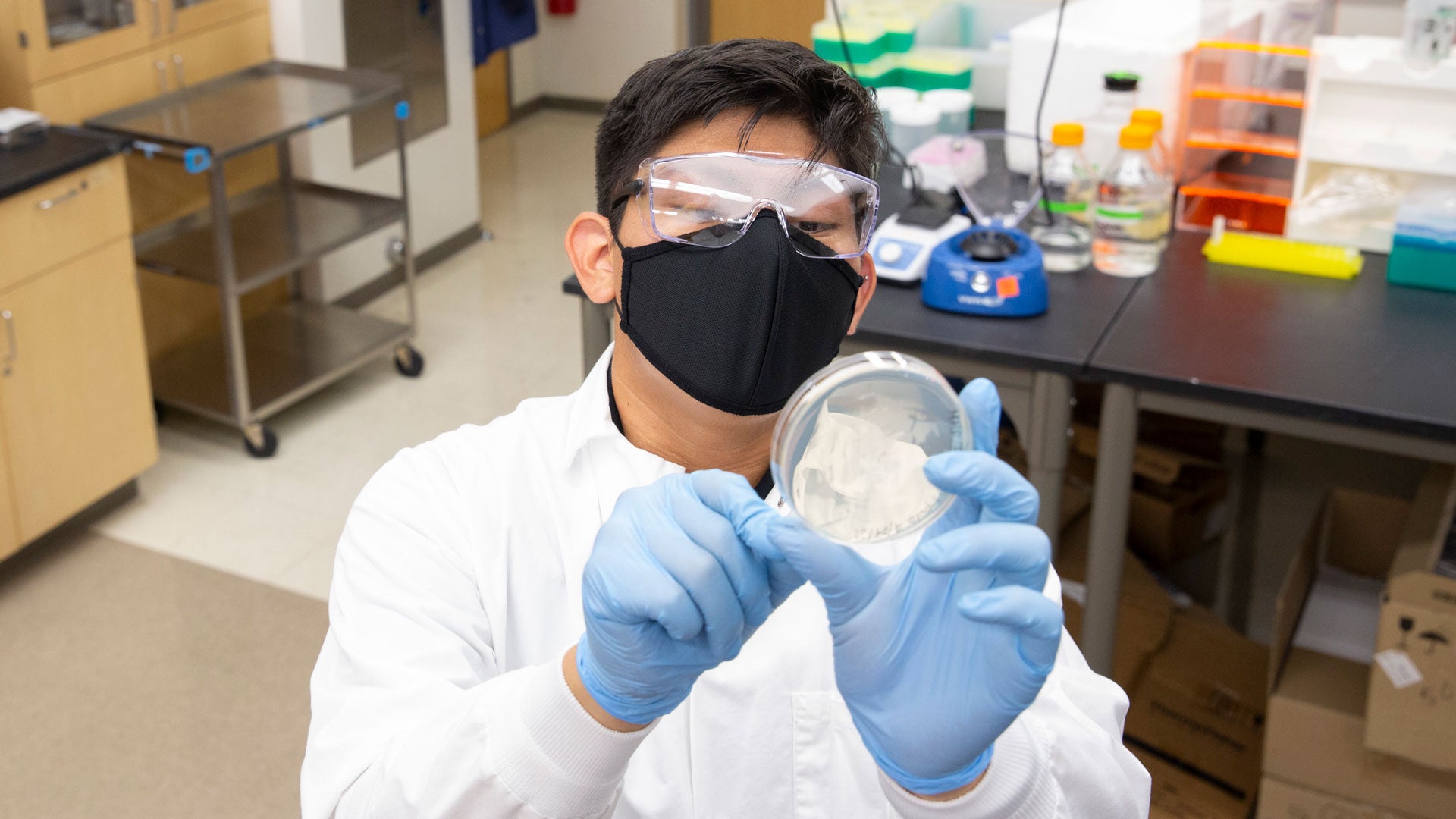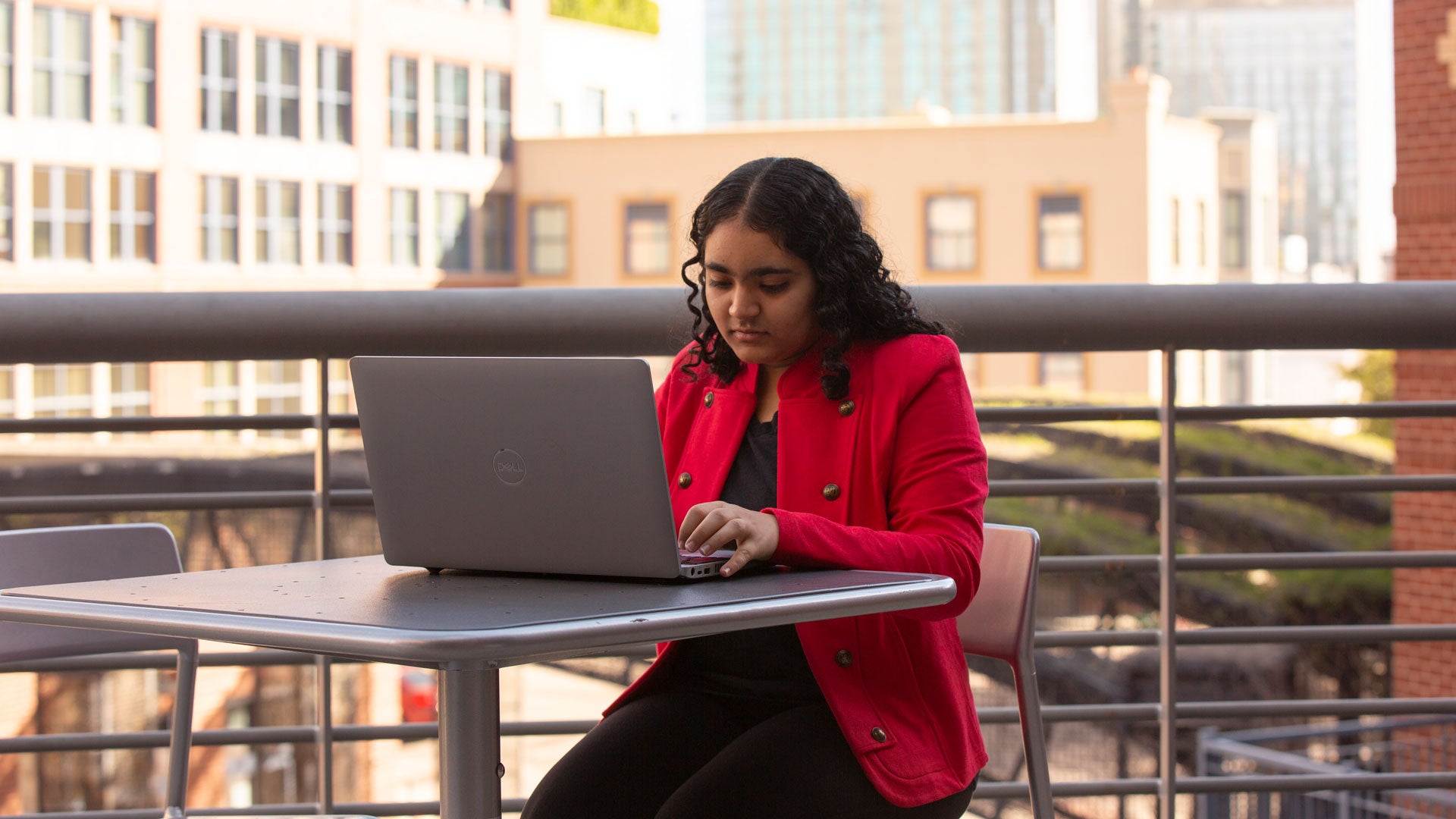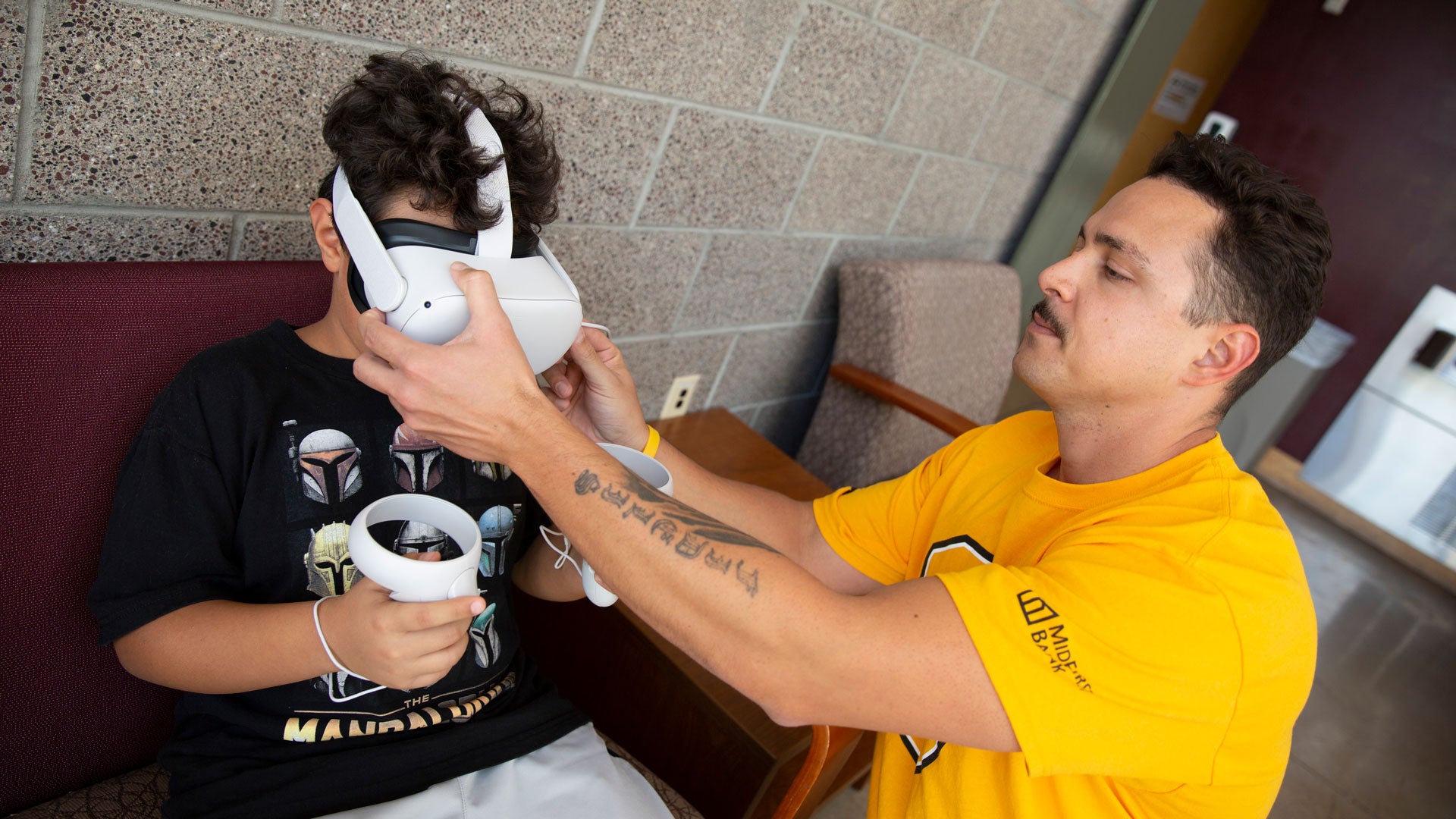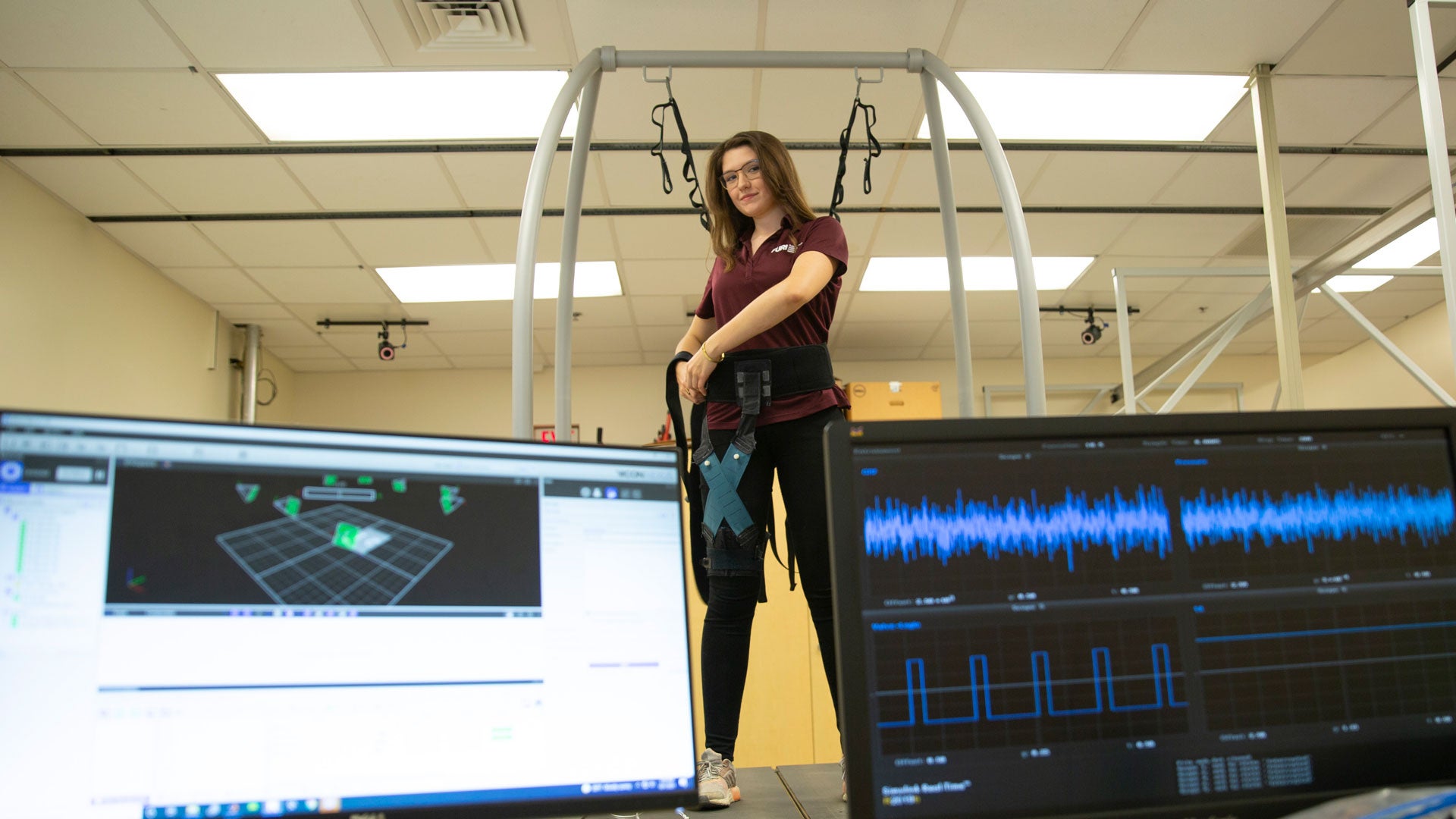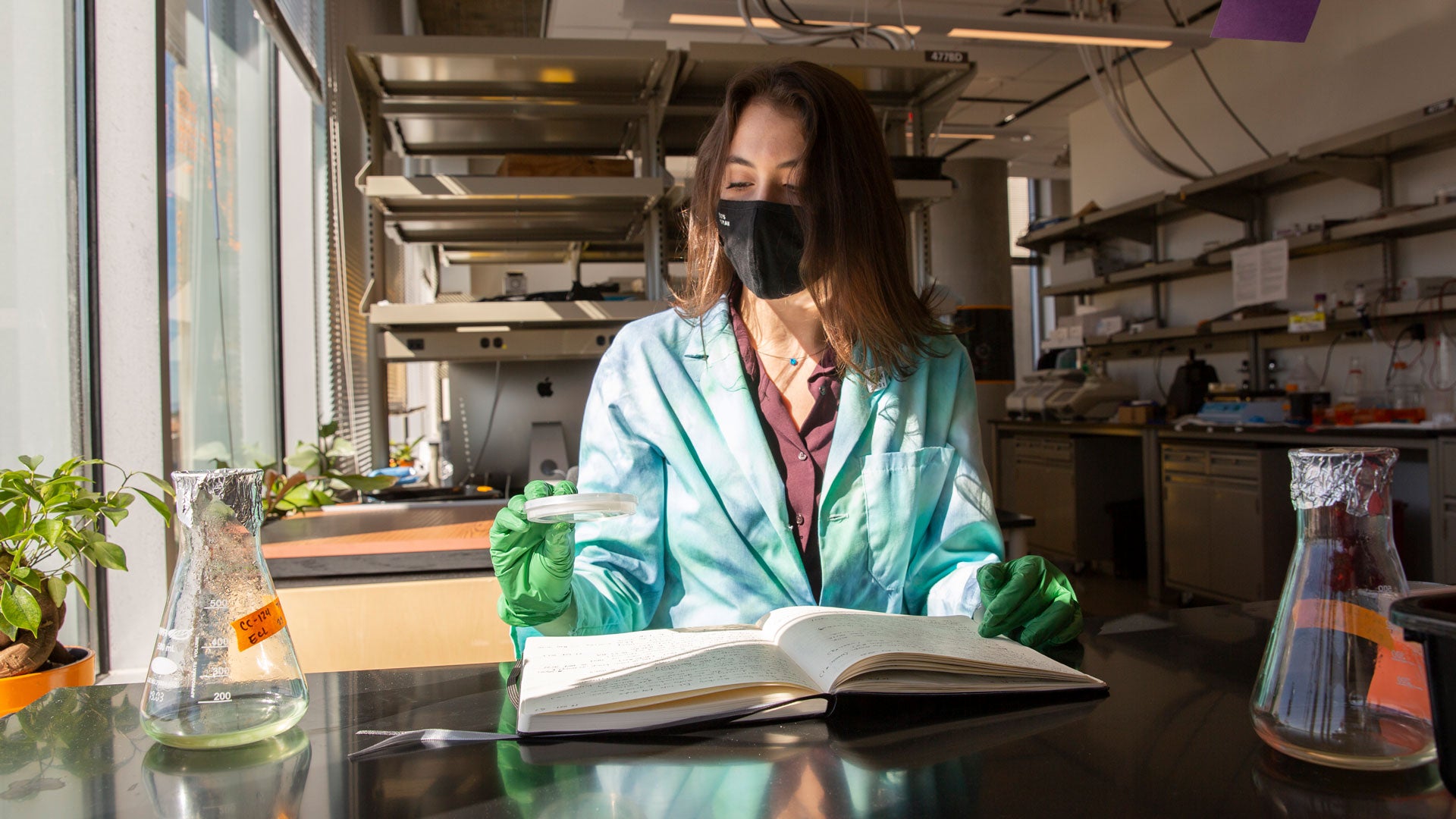Engineering beyond the classroom

ASU electrical engineering graduate student S. Saketha Ramanujam Samavedam peers into the lenses of an imaging device that can see around obstacles. Samavedam is conducting research in the Master’s Opportunity for Research in Engineering program, one of the research programs that students in the Ira A. Fulton Schools of Engineering at ASU can participate in to enhance their classroom experience through hands-on learning with faculty mentors. Photo by Erika Gronek/ASU
Developing gene therapies for cancer treatment, gamifying engineering education, bringing virtual reality therapy to children with autism, building a robotic hip exosuit and removing arsenic from groundwater with microalgae. These are five of the many ways students in the Ira A. Fulton Schools of Engineering at Arizona State University are already impacting the world.
Engineering and technology students can enhance their education by applying classroom knowledge and learning new skills through hands-on research. They’re also profoundly affecting their communities — both local and global — by pursuing research topics that interest them.
Undergraduate and graduate students can take advantage of multiple opportunities in the Fulton Schools to engage in research that addresses real-world challenges in data science, education, energy, health, security and sustainability.
The Fulton Undergraduate Research Initiative, or FURI, and the Master’s Opportunity for Research in Engineering, or MORE, programs challenge students to spend a semester conceptualizing an idea, developing a plan and investigating their research question with a faculty mentor.
Students in the Grand Challenges Scholars Program, or GCSP, can choose to take on a research project as part of the program’s required competencies that uniquely prepare them to solve challenges we face as a global society.
These three opportunities promote growth in students’ ability to innovate, think independently and solve problems they see in their communities. They also help students gain skills that will support their careers or pursuits to earn advanced degrees.
Students who participate in FURI, MORE and GCSP are invited to present their research findings at the biannual FURI Symposium.
Here, learn about five Fulton Schools students participating in the fall 2021 FURI Symposium. Then meet these students and more than 80 other student investigators at the event, open to the public, held from 1 to 3 p.m. Friday, Nov. 19, on the ASU Tempe campus.
Margarito Hernandez Fuentes, biomedical engineering FURI researcher
Biomedical engineering senior Margarito Hernandez Fuentes is researching gene therapies for pleural mesothelioma cancer with Christopher Plaisier, an assistant professor of biomedical engineering. Photo by Erika Gronek/ASU
Margarito Hernandez Fuentes is a biomedical engineering senior researching gene therapies for cancer in Assistant Professor Christopher Plaisier’s lab. Hernandez Fuentes says he has always been in awe of the lab environment and thinks researchers look so cool in their lab coats. Now that his research dream has become a reality, he is excited to share his FURI experience.
Question: Why did you choose the project you’re working on?
Answer: I chose to work on cancer biology research because I am interested in the wet-lab aspect of bioengineering. The thought of using engineering to solve critical health issues never fails to excite me. I am especially interested in using bioengineering approaches to solve health disparities. With my research project, I hope to do just that.
Q: How will your engineering research project impact the world?
A: Pleural mesothelioma is a malignant cancer with a grim survival rate. Current treatment options are insufficient and come with devastating effects. My research project aims to find alternative treatment options by inhibiting the growth of the cancer through gene silencing. With my research, I hope to move one step closer to revolutionizing cancer treatment and provide better outcomes for patients struggling with this disease.
Q: What has been your most memorable experience as a student researcher?
A: One memorable experience was finally being able to see so many concepts and techniques I learned in class being used in my research lab. It was exciting learning so many new lab techniques and being able to understand their role in my experiment.
Q: How do you see this experience helping you with your advanced degree goals?
A: As an aspiring physician-scientist, this experience will prepare me to tackle research questions from an engineering approach. With a background in bioengineering, I see myself approaching health issues through a new lens. In addition, I am more than certain that the lab techniques learned from this experience will be used consistently through my pursuit of a graduate degree.
Q: Why should other students get involved in this program?
A: For undergraduates looking to gain any experience in research, the FURI program is the best way to do just that. While students are more than able to conduct research outside of FURI, this program dedicates its resources and mentors to hone students’ research and presentation skills.
Learn more about Hernandez Fuentes’s fall 2021 FURI project
Tina Sindwani, computer systems engineering FURI researcher
Computer systems engineering sophomore Tina Sindwani is researching how gamification can improve student motivation and success in engineering courses with Senior Lecturer Haolin Zhu and Lecturer Alicia Baumann. Photo by Erika Gronek/ASU
Computer systems engineering sophomore Tina Sindwani is investigating how gamifying engineering courses impacts student motivation and success in her FURI project with Senior Lecturer Haolin Zhu and Lecturer Alicia Baumann. Sindwani is interested in improving how instructors teach technical science, technology, engineering and math concepts for her FURI project, as well as her work in GCSP and honors thesis in ASU’s Barrett, The Honors College, and her own nonprofit organization called The Scientific Teen.
Question: What made you want to get involved in FURI and the project you’re working on?
Answer: I wanted to get involved with FURI and this project because I wanted to explore how we can make the educational experience more engaging and enlightening for students. I love learning and teaching others, and I want to make sure that as educators we are as prepared and knowledgeable as we can be about the learning needs of our students. Our project explores gamification in engineering education and how it affects student motivation. The results of this research can help us find what gamification techniques, if any, can help improve student engagement and performance.
Q: How will your engineering research project impact the world?
A: STEM education really has the power to change the world. People can learn to engineer themselves out of their own problems. Unfortunately, in many parts of the world, it’s not taught well, or at all. Engineering is often seen as a set of difficult subjects that can only be learned by the “smartest” people or by rote memorization, and that is the opposite of reality. In reality, we are all curious and inquisitive in our own ways. We may not realize it, but we use science and technology in nearly every aspect of our lives. Knowing how the forces of nature work and how we can manipulate them can help empower people to make things better for themselves by using those skills and knowledge.
Q: What has been your most memorable experience as a student researcher?
A: My most memorable experience was realizing that so many students had found gamification useful. As someone interested in improving education, this was an exciting find for me.
Q: How has this experience helped you in other areas of your life?
A: I am a computer systems engineering student myself, and learning what techniques help or don’t help educate students can help me as a student as well. It can give me new perspectives as a learner.
I also run an international STEM communication nonprofit called The Scientific Teen with the goal to educate people on STEM topics and to encourage STEM career pathways. This project can help me apply the techniques that help students learn to my own nonprofit work as well as international education work I see myself doing in the future.
Q: What is the best advice you’ve gotten from your faculty mentor?
A: Take it patiently — research is a long but rewarding process!
Q: Why should other students get involved in FURI?
A: FURI is a great way to get research experience and explore your interests while being mentored by an expert. It’s the perfect way to explore research while you are still in college. I am extremely glad I took on the challenge of this experience.
Learn more about Sindwani’s fall 2021 FURI project
Gil E. Ruiz, engineering FURI researcher
Engineering sophomore Gil E. Ruiz is researching a virtual-reality-based therapy method for children with autism spectrum disorder with his son and Maria Elena Chavez-Echeagaray, a computer science lecturer. Photo by Erika Gronek/ASU
Gil E. Ruiz is an engineering senior exploring the use of virtual reality and biosensors for comprehensive therapy for children with autism spectrum disorder with chemical engineering senior Ignazio Macaluso and Lecturer Maria Elena Chavez-Echeagaray. It’s a challenging research topic that involves diverse disciplines, from computer science to health-related areas. Finding the right people to cover the different points of view and expertise needed for this project has represented one of the major challenges, in particular finding a board-certified behavior analyst to work with, but Ruiz says taking on a personally rewarding project has made the experience worth dealing with such interesting challenges.
Question: Why did you choose the project you’re working on?
Answer: My son is autistic, and over time I have realized that neuroatypical individuals do not have the same opportunities as neurotypical individuals. This is due to the lack of tools they possess to make the choice and pursue the opportunity. My goal is to provide the right tools for neuroatypical individuals for them to have the freedom of making a very important choice: Do I pursue this opportunity or not?
Q: How will your engineering research project impact the world?
A: We want to prove that applied behavior analysis therapy and many other methodologies can be applied through virtual reality and biometric sensors to create more immersive and natural experiences that improve the experience of the children.
Q: How do you see this experience helping with your career?
A: This experience will help me improve my technical skills by creating a solution that impacts the community, it will help provide the opportunity to create a competitive and diverse team, and it will provide the opportunity to collaborate and efficiently communicate with professionals from diverse backgrounds.
Q: What stands out to you about your FURI experience?
A: This is by far the most difficult and demanding task I have ever had to accomplish academically. I welcome it with open arms.
Q: What is the best advice you’ve gotten from your faculty mentor?
A: Take it one step at a time — it always works.
Learn more about Ruiz’s fall 2021 FURI project
Lily Baye-Wallace, robotics and autonomous systems MORE researcher
Robotics and autonomous systems graduate student Lily Baye-Wallace is developing a soft robotic hip exosuit for rehabilitative assistance with Hyunglae Lee, an associate professor of mechanical and aerospace engineering. Photo by Erika Gronek/ASU
Lily Baye-Wallace, a robotics and autonomous systems graduate student focusing on mechanical and aerospace engineering, is working on a MORE project with Associate Professor Hyunglae Lee to develop a soft robotic hip exosuit that can provide rehabilitative assistance. Baye-Wallace has even submitted a provisional patent from her research with support from ASU.
Question: What made you want to get involved in MORE?
Answer: I met two students who had worked on soft robotic orthoses with Dr. Lee through the Society of Women Engineers ASU section and they absolutely loved the research. When I was beginning my search for an adviser for my master’s thesis, I met then-PhD candidate and now Dr. Carly Thalman while salsa dancing and learned that the next project she was going to start coincidentally needed an additional graduate student. I started working with her later that week.
Q: How will your engineering research project impact the world?
A: This is the lightest robotic hip exosuit on the market, and it’s incredibly affordable to manufacture, which could be groundbreaking in the realm of assistive and rehabilitative devices for hemiparesis patients (those experiencing partial loss of strength on one side of the body) from the perspective of cost. I’m excited to test the limits of its rehabilitative potential in our next internal study and hopefully clinical trials.
Q: Did you have a particular “aha!” moment during your project?
A: Most hip-based robotics utilize either motor-driven rigid limbs or Bowden cables. Our pneumatic muscles for the exosuit are uniquely lightweight, but they also don’t automatically change their own amount of tension, which is preset in the fitting and can be adjusted between uses but not while a participant is actively walking. Orienting the actuators in an “X” shape was a big game-changer — it achieves a low-profile look and hugs the leg for maximum force transmission without getting in the way of natural hip motion.
Q: How do you see this experience helping with your career?
A: It’s my desire to develop medical devices for a living, ideally wearables for rehabilitation — like this suit — but I would also love to try my hand at robotic prostheses and minimally invasive surgical robots. I’ve obtained an institutional review board clearance and have practiced the development and running of human suit studies. I’ve learned more about gait biomechanics, and I’ve obtained straightforward practical skills like collecting surface electromyography data and motion capture. This has also been submitted for a provisional patent, which is a great credential to have while working for product design and test positions. I think all of these skills will be directly applicable to work in the design and testing of other wearable consumer devices.
Q: Why should other students get involved in these Fulton Schools research programs?
A: FURI, MORE and GCSP are simple, straightforward ways to obtain funding to work on almost any engineering project of any scope. It makes paid research really accessible and gives you the opportunity to try new things out and see what you’re interested in. At this point, I’ve worked in three labs at ASU, and I’m grateful I had the opportunity to obtain such a breadth of research experience.
Learn more about Baye-Wallace’s summer 2021 MORE project
Emma Lieberman, biomedical engineering GCSP researcher
Biomedical engineering senior Emma Lieberman is researching decontamination techniques to reduce arsenic in local groundwater with Christopher Plaisier and Benjamin Bartelle, two assistant professors of biomedical engineering. Photo by Erika Gronek/ASU
Emma Lieberman is a biomedical engineering senior in the Grand Challenges Scholars Program who is presenting water decontamination research conducted with Assistant Professor Christopher Plaisier at the FURI Symposium. Lieberman worked on her talent competency of GCSP through opportunities with the ASU iGEM competition team and research with Plaisier and Assistant Professor Benjamin Bartelle.
Question: What made you want to get involved in GCSP?
Answer: I was originally drawn to the Grand Challenges Scholars Program my freshman year. I like that it gives undergraduates the opportunity to contextualize everything we’re learning in the real world, and helps us consider how to provide value through our work.
Q: How will your engineering research project impact the world?
A: For this project, I was a member of ASU’s team participating in the International Genetically Engineered Machine, or iGEM, annual competition. iGEM puts a lot of emphasis on addressing local issues ethically. As a co-captain for the team, and the head of our human practices efforts, we explored how prolonged exposure to high arsenic concentrations in water can have devastating effects on people, livestock and the environment. Hopefully, this project and the proposed filter design and implementation method we developed will help people have better access to safe drinking water. This would help people in rural communities to maintain the integrity of their environment and live healthier lives.
Q: How do you see this experience helping your career?
A: Being a member of GCSP will help me show my dedication to improving lives and providing value to our society through biomedical engineering. Participating in the iGEM competition has been an amazing learning opportunity. I’ve learned a plethora of skills that will help me immensely in my career — not only wet lab skills, but also project planning, leadership and research skills that I am excited to utilize in future projects.
Q: What is the best advice you’ve gotten from your faculty mentor?
A: Dr. Plaisier advised us to design our protocols thoroughly, check them with others and run them at least once before we needed to. This was great advice. No matter how thoroughly you think the protocols are researched, there is always something that will come up when you’re in the lab. It’s also helpful knowing that the cloning issues, lab setbacks and failed experiments happen to everyone, and can almost always be solved with a little more time, research, meetings with advisers and trial and error.
Q: Why should other students get involved in GCSP?
A: I highly recommend other Fulton Schools students become involved in GCSP regardless of their engineering major. It is encouraging to be part of a community that is so optimistic about improving lives with our engineering skills. I also recommend that students become involved in future ASU iGEM teams. This year reignited our team, and we hope to take an active part in this annual competition for many years to come!
More Science and technology

Breakthrough copper alloy achieves unprecedented high-temperature performance
A team of researchers from Arizona State University, the U.S. Army Research Laboratory, Lehigh University and Louisiana State…

4 ASU researchers named senior members of the National Academy of Inventors
The National Academy of Inventors recently named four Arizona State University researchers as senior members to the prestigious…

Transforming Arizona’s highways for a smoother drive
Imagine you’re driving down a smooth stretch of road. Your tires have firm traction. There are no potholes you need to swerve to…


